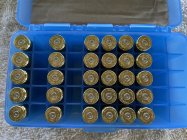On my second firing of Lapua Brass I'm getting high pressure signs heavy bolt lift, ejector swipes and partially flat primers.
Shooting virgin Lapua Br brass had no pressure signs same load 28.5, resized the brass and started load testing from 25 - 28.5 and every case had ejector swipe and heavy bolt lift. The chamber was dry and the barrel had 39 rounds down the pipe since the last cleaning.
FPS 2575 at 28 grains of varget
Terminus Zeus QC barrel
Bartlien 1:8 twist 6mm HV barrel
.272 neck chamber
.120 Freebore
Varget (25-28.5gr)
CCI BR4
105gr Hornady HPBT
Tested at .020 - .035 off the lands.
Shoulder bump .002
Loaded round is .268 - .269.
Brass neck thickness at .0127 - .013 for a total of around .026.
Lapua Case OAL 1.556
Lapua Case OAL 1.554
Lapua Case OAL trimmed 1.551
I bore scoped the the fired brass in the chamber and it has lots of clearance for OAL.
OD fired case .2705-.271
OD fired round .268-.269
Chambering empty case new and sized is fine
Chambering a fired case is heavy bolt closure.
Snug fit when trying to insert a bullet into a fired case.
I’m using a Redding type S die (.267 Bushing) and noticed that the base of the neck that is unsized is .2705 and I have a .272 neck.
Does that come into play when measuring loaded rounds vs chamber neck size?
Could the BR4 primers be causing the high pressure?
View attachment 1312321











